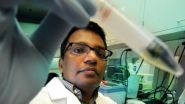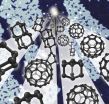(Press-News.org) Tiny single-cell organisms discovered living underground could help with the problem of nuclear waste disposal, say researchers involved in a study at The University of Manchester.
Although bacteria with waste-eating properties have been discovered in relatively pristine soils before, this is the first time that microbes that can survive in the very harsh conditions expected in radioactive waste disposal sites have been found. The findings are published in the ISME (Multidisciplinary Journal of Microbial Ecology) Journal.
The disposal of our nuclear waste is very challenging, with very large volumes destined for burial deep underground. The largest volume of radioactive waste, termed "intermediate level" and comprising of 364,000m3 (enough to fill four Albert Halls), will be encased in concrete prior to disposal into underground vaults. When ground waters eventually reach these waste materials, they will react with the cement and become highly alkaline. This change drives a series of chemical reactions, triggering the breakdown of the various "cellulose" based materials that are present in these complex wastes.
One such product linked to these activities, isosaccharinic acid (ISA), causes much concern as it can react with a wide range of radionuclides - unstable and toxic elements that are formed during the production of nuclear power and make up the radioactive component of nuclear waste. If the ISA binds to radionuclides, such as uranium, then the radionuclides will become far more soluble and more likely to flow out of the underground vaults to surface environments, where they could enter drinking water or the food chain. However, the researchers' new findings indicate that microorganisms may prevent this becoming a problem.
Working on soil samples from a highly alkaline industrial site in the Peak District, which is not radioactive but does suffer from severe contamination with highly alkaline lime kiln wastes, they discovered specialist "extremophile" bacteria that thrive under the alkaline conditions expected in cement-based radioactive waste. The organisms are not only superbly adapted to live in the highly alkaline lime wastes, but they can use the ISA as a source of food and energy under conditions that mimic those expected in and around intermediate level radwaste disposal sites. For example, when there is no oxygen (a likely scenario in underground disposal vaults) to help these bacteria "breath" and break down the ISA, these simple single cell microorganisms are able to switch their metabolism to breath using other chemicals in the water, such as nitrate or iron.
The fascinating biological processes that they use to support life under such extreme conditions are being studied by the Manchester group, as well as the stabilizing effects of these humble bacteria on radioactive waste. The ultimate aim of this work is to improve our understanding of the safe disposal of radioactive waste underground by studying the unusual diet of these hazardous waste eating microbes.
One of the researchers, Professor Jonathan Lloyd, in the University's School of Earth, Atmospheric and Environmental Sciences, said: "We are very interested in these Peak District microorganisms. Given that they must have evolved to thrive at the highly alkaline lime-kiln site in only a few decades, it is highly likely that similar bacteria will behave in the same way and adapt to living off ISA in and around buried cement-based nuclear waste quite quickly.
"Nuclear waste will remain buried deep underground for many thousands of years so there is plenty of time for the bacteria to become adapted. Our next step will be to see what impact they have on radioactive materials. We expect them to help keep radioactive materials fixed underground through their unusual dietary habits, and their ability to naturally degrade ISA."
INFORMATION:
Notes to Editors:
The paper "Microbial degradation of isosaccharinic acid at high pH" is published in The ISME Journal, DOI: ISMEJ.2014.125
Scientists discover hazardous waste-eating bacteria
2014-09-09
ELSE PRESS RELEASES FROM THIS DATE:
Estrogen receptor expression may help explain why more males have autism
2014-09-09
AUGUSTA, Ga. – The same sex hormone that helps protect females from stroke may also reduce their risk of autism, scientists say.
In the first look at a potential role of the female sex hormone in autism, researchers at the Medical College of Georgia at Georgia Regents University have found expression of estrogen receptor beta – which enables estrogen's potent brain protection – is significantly decreased in autistic brains. The receptor also plays a role in locomotion as well as behavior, including anxiety, depression, memory, and learning.
"If you ask any psychiatrist ...
Phosphorus a promising semiconductor
2014-09-09
Defects damage the ideal properties of many two-dimensional materials, like carbon-based graphene. Phosphorus just shrugs.
That makes it a promising candidate for nano-electronic applications that require stable properties, according to new research by Rice University theoretical physicist Boris Yakobson and his colleagues.
In a paper in the American Chemical Society journal Nano Letters, the Rice team analyzed the properties of elemental bonds between semiconducting phosphorus atoms in 2-D sheets. Two-dimensional phosphorus is not theoretical; it was recently created ...
A system that facilitates malware identification in smartphones
2014-09-09
Malware is a type of malicious program whose general aim is to profit economically by carrying out actions without the user's consent, such as stealing personal information or committing economic fraud. We can find it "in any type of device ranging from traditional cell phones to today's smartphones, and even in our washing machine," explained one of the researchers, Guillermo Suarez de Tangil, from the Computer Science Department at UC3M.
With the massive sales of smartphones in recent years (more than personal computers in all of their history), malware developers ...
Testing the fossil record
2014-09-09
Palaeontologists have developed methods to try to identify and correct for bias and incompleteness in the fossil record. A new study, published on 4 September 2014 in the journal Nature Communications, suggests that some of these correction methods may actually be misleading. The work is led by Dr Alex Dunhill (University of Leeds, formerly at the Universities of Bath and Bristol), together with Hannisdal (University of Bergen) and Professor Michael Benton (University of Bristol).
Back to the origin of animals
"The Earth keeps changing. Life keeps evolving. And there ...
How age alters our immune response to bereavement
2014-09-09
Young people have a more robust immune response to the loss of a loved one, according to new research from the University of Birmingham, providing insight into how different generations cope with loss.
The study, published in the journal Immunity and Ageing, shows how the balance of our stress hormones during grief changes as we age – meaning elderly people are more likely to have reduced immune function and, as a result, suffer from infections.
It is the first research to compare different generations and display the relationship between stress hormones and immune ...
Myriad myPath™ melanoma test reduced indeterminate cases by 76 percent
2014-09-09
SALT LAKE CITY, Utah, Sept. 9, 2014 – Myriad Genetics, Inc. (Nasdaq: MYGN) today presented results from a pivotal clinical utility study of the Myriad myPath™ Melanoma test at the 2014 College of American Pathologists (CAP) annual meeting in Chicago, Ill. Myriad myPath Melanoma is a novel diagnostic test that differentiates malignant melanoma from benign skin lesions with greater than 90 percent accuracy and helps physicians deliver a more objective and confident diagnosis for patients.
This study evaluated the impact of the myPath Melanoma diagnostic test on expert ...
Biologists try to dig endangered pupfish out of its hole
2014-09-09
Berkeley — Scientists estimate that fewer than 100 Devils Hole pupfish remain in their Mojave Desert home, but a conservation biologist at the University of California, Berkeley, is giving important guidance in the efforts to rescue them by establishing a captive breeding program.
Considered the world's rarest fish, with one of the smallest geographic ranges of any wild vertebrate, the tiny pupfish (Cyprinodon diabolis) – about one-inch long as an adult – neared extinction in spring 2013 when populations dropped to an all-time low of 35 observable pupfish. While more ...
Tracing water channels in cell surface receptors
2014-09-09
G protein-coupled receptors (GPCRs) are the largest class of cell surface receptors in our cells, involved in signal transmission across the cell membrane. One of the biggest questions is how a signal recognized at the extracellular side of a GPCR induces a sequence of conformational changes in the protein and finally evokes an intracellular response. EPFL scientists have now used computer modeling to reveal in molecular detail the structural transitions that happen inside GPCRs during the signal transduction process. They discovered that a central step in the trans-membrane ...
Shift in Arabia sea plankton may threaten fisheries
2014-09-09
A growing "dead zone" in the middle of the Arabian Sea has allowed plankton uniquely suited to low-oxygen water to take over the base of the food chain. Their rise to dominance over the last decade could be disastrous for the predator fish that sustain 120 million people living on the sea's edge.
Scientists at Columbia University's Lamont-Doherty Earth Observatory and their colleagues are the first to document the rapid rise of green Noctiluca scintillans, an unusual dinoflagellate that eats other plankton and draws energy from the sun via microscopic algae living within ...
Buckyballs and diamondoids join forces in tiny electronic gadget
2014-09-09
Menlo Park, Calif. — Scientists have married two unconventional forms of carbon – one shaped like a soccer ball, the other a tiny diamond – to make a molecule that conducts electricity in only one direction. This tiny electronic component, known as a rectifier, could play a key role in shrinking chip components down to the size of molecules to enable faster, more powerful devices.
"We wanted to see what new, emergent properties might come out when you put these two ingredients together to create a 'buckydiamondoid,'" said Hari Manoharan of the Stanford Institute for Materials ...





